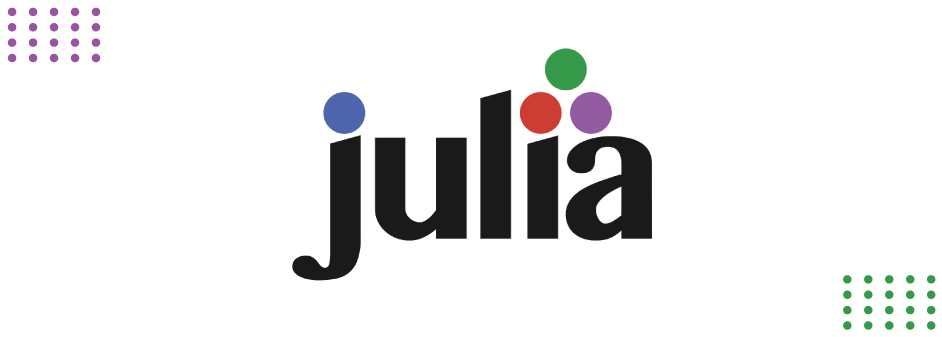Exploring Julia: The Programming Language for Data Science and Machine Learning in 2024

In the rapidly evolving landscape of data science and machine learning, choosing the right programming language is crucial for maximizing productivity and efficiency. While Python and R have traditionally dominated this field, Julia is emerging as a powerful alternative. Designed for high-performance numerical and scientific computing, Julia offers a unique combination of speed and ease of use that makes it particularly well-suited for data science and machine learning tasks. In this blog, we’ll explore why Julia is becoming the programming language of choice for data science and machine learning in 2024.
Introduction to Julia
Overview: Julia is a high-level, high-performance programming language developed specifically for numerical and scientific computing. It was created with the goal of combining the ease of use of Python with the speed of C, making it an attractive option for data scientists and machine learning practitioners.
Key Features:
- High Performance: Julia is designed for high-speed execution, often outperforming Python and R in computational tasks.
- Dynamic Typing: Julia is dynamically typed, making it flexible and easy to use for rapid prototyping.
- Multiple Dispatch: This feature allows functions to be defined for different combinations of argument types, enhancing code versatility and reusability.
Julia's Advantages for Data Science
Overview: Julia’s features and capabilities make it particularly advantageous for data science applications, offering both performance and productivity benefits.
Key Advantages:
- Speed: Julia’s performance is comparable to languages like C and Fortran, which are traditionally used for high-performance computing tasks. This makes it ideal for handling large datasets and complex computations.
- Ease of Use: Julia’s syntax is clean and easy to learn, similar to Python. This reduces the learning curve and allows data scientists to quickly become productive.
- Rich Ecosystem: Julia has a growing ecosystem of packages and libraries specifically designed for data science, including DataFrames.jl for data manipulation and JuliaDB for database operations.
Impact:
- Faster processing times for large datasets and complex algorithms.
- Increased productivity due to easy-to-read syntax and dynamic typing.
- Access to powerful tools and libraries designed for data science.
Julia for Machine Learning
Overview: Julia’s performance and ease of use extend to machine learning, where it offers significant advantages over other languages.
Key Features:
- Flux.jl: A flexible machine learning library for Julia that provides the tools needed to build and train models easily.
- Knet.jl: Another popular deep learning framework in Julia, known for its performance and flexibility.
- Automatic Differentiation: Julia’s built-in support for automatic differentiation simplifies the implementation of gradient-based optimization algorithms, essential for training machine learning models.
Impact:
- Efficient training and deployment of machine learning models.
- Simplified implementation of complex algorithms.
- Access to state-of-the-art machine learning frameworks.
Julia's Growing Community and Ecosystem
Overview: Julia’s community and ecosystem are rapidly expanding, contributing to its adoption and development.
Key Developments:
- Community Support: Julia has a vibrant and active community that contributes to its development and provides support to new users.
- Package Ecosystem: The Julia package ecosystem is growing, with contributions from both academia and industry. This includes packages for data manipulation, visualization, and machine learning.
- Interoperability: Julia can easily call functions from Python, C, and R, allowing users to leverage existing code and libraries.
Impact:
- Enhanced support and resources for learning and using Julia.
- Continuous development and improvement of Julia packages.
- Ability to integrate Julia with other programming languages and tools.
Real-World Applications of Julia in 2024
Overview: Julia’s capabilities are being recognized and utilized in various real-world applications across different industries.
Key Applications:
- Finance: Julia is used for quantitative analysis, risk management, and algorithmic trading due to its high performance and accuracy.
- Healthcare: Researchers use Julia for bioinformatics, genomics, and medical imaging, benefiting from its speed and ease of use.
- Academia: Julia is increasingly adopted in academic research for simulations, modeling, and data analysis.
Impact:
- Accelerated research and development in various fields.
- Improved efficiency and accuracy in data analysis and modeling.
- Broader adoption of Julia in industry and academia.
Conclusion
As we move into 2024, Julia is poised to become a leading programming language for data science and machine learning. Its unique combination of speed, ease of use, and a growing ecosystem makes it an attractive option for professionals looking to maximize their productivity and efficiency. By exploring Julia and incorporating it into your workflow, you can stay ahead of the curve and leverage the latest advancements in data science and machine learning.
FAQs
What is Julia and why is it important for data science?
Julia is a high-performance programming language designed for numerical and scientific computing. Its speed and ease of use make it ideal for data science, allowing for efficient handling of large datasets and complex computations.
How does Julia compare to Python and R for data science?
Julia often outperforms Python and R in terms of speed due to its high-performance design. It combines the ease of use of Python with the speed of C, making it a powerful alternative for data science tasks.
What are some key packages in Julia for data science and machine learning?
Key packages include DataFrames.jl for data manipulation, JuliaDB for database operations, Flux.jl for machine learning, and Knet.jl for deep learning.
How is Julia being used in real-world applications?
Julia is used in various industries, including finance for quantitative analysis, healthcare for bioinformatics and genomics, and academia for research and modeling.
How can I get started with Julia for data science?
You can start by exploring Julia’s official documentation, joining the Julia community, and experimenting with packages like DataFrames.jl and Flux.jl. Online courses and tutorials can also help you learn the basics and advance your skills.
In the rapidly evolving landscape of data science and machine learning, choosing the right programming language is crucial for maximizing productivity and efficiency. While Python and R have traditionally dominated this field, Julia is emerging as a powerful alternative. Designed for high-performance numerical and scientific computing, Julia offers a unique combination of speed and ease of use that makes it particularly well-suited for data science and machine learning tasks. In this blog, we’ll explore why Julia is becoming the programming language of choice for data science and machine learning in 2024.
Introduction to Julia
Overview: Julia is a high-level, high-performance programming language developed specifically for numerical and scientific computing. It was created with the goal of combining the ease of use of Python with the speed of C, making it an attractive option for data scientists and machine learning practitioners.
Key Features:
- High Performance: Julia is designed for high-speed execution, often outperforming Python and R in computational tasks.
- Dynamic Typing: Julia is dynamically typed, making it flexible and easy to use for rapid prototyping.
- Multiple Dispatch: This feature allows functions to be defined for different combinations of argument types, enhancing code versatility and reusability.
Julia's Advantages for Data Science
Overview: Julia’s features and capabilities make it particularly advantageous for data science applications, offering both performance and productivity benefits.
Key Advantages:
- Speed: Julia’s performance is comparable to languages like C and Fortran, which are traditionally used for high-performance computing tasks. This makes it ideal for handling large datasets and complex computations.
- Ease of Use: Julia’s syntax is clean and easy to learn, similar to Python. This reduces the learning curve and allows data scientists to quickly become productive.
- Rich Ecosystem: Julia has a growing ecosystem of packages and libraries specifically designed for data science, including DataFrames.jl for data manipulation and JuliaDB for database operations.
Impact:
- Faster processing times for large datasets and complex algorithms.
- Increased productivity due to easy-to-read syntax and dynamic typing.
- Access to powerful tools and libraries designed for data science.
Julia for Machine Learning
Overview: Julia’s performance and ease of use extend to machine learning, where it offers significant advantages over other languages.
Key Features:
- Flux.jl: A flexible machine learning library for Julia that provides the tools needed to build and train models easily.
- Knet.jl: Another popular deep learning framework in Julia, known for its performance and flexibility.
- Automatic Differentiation: Julia’s built-in support for automatic differentiation simplifies the implementation of gradient-based optimization algorithms, essential for training machine learning models.
Impact:
- Efficient training and deployment of machine learning models.
- Simplified implementation of complex algorithms.
- Access to state-of-the-art machine learning frameworks.
Julia's Growing Community and Ecosystem
Overview: Julia’s community and ecosystem are rapidly expanding, contributing to its adoption and development.
Key Developments:
- Community Support: Julia has a vibrant and active community that contributes to its development and provides support to new users.
- Package Ecosystem: The Julia package ecosystem is growing, with contributions from both academia and industry. This includes packages for data manipulation, visualization, and machine learning.
- Interoperability: Julia can easily call functions from Python, C, and R, allowing users to leverage existing code and libraries.
Impact:
- Enhanced support and resources for learning and using Julia.
- Continuous development and improvement of Julia packages.
- Ability to integrate Julia with other programming languages and tools.
Real-World Applications of Julia in 2024
Overview: Julia’s capabilities are being recognized and utilized in various real-world applications across different industries.
Key Applications:
- Finance: Julia is used for quantitative analysis, risk management, and algorithmic trading due to its high performance and accuracy.
- Healthcare: Researchers use Julia for bioinformatics, genomics, and medical imaging, benefiting from its speed and ease of use.
- Academia: Julia is increasingly adopted in academic research for simulations, modeling, and data analysis.
Impact:
- Accelerated research and development in various fields.
- Improved efficiency and accuracy in data analysis and modeling.
- Broader adoption of Julia in industry and academia.
Conclusion
As we move into 2024, Julia is poised to become a leading programming language for data science and machine learning. Its unique combination of speed, ease of use, and a growing ecosystem makes it an attractive option for professionals looking to maximize their productivity and efficiency. By exploring Julia and incorporating it into your workflow, you can stay ahead of the curve and leverage the latest advancements in data science and machine learning.
FAQs
What is Julia and why is it important for data science?
Julia is a high-performance programming language designed for numerical and scientific computing. Its speed and ease of use make it ideal for data science, allowing for efficient handling of large datasets and complex computations.
How does Julia compare to Python and R for data science?
Julia often outperforms Python and R in terms of speed due to its high-performance design. It combines the ease of use of Python with the speed of C, making it a powerful alternative for data science tasks.
What are some key packages in Julia for data science and machine learning?
Key packages include DataFrames.jl for data manipulation, JuliaDB for database operations, Flux.jl for machine learning, and Knet.jl for deep learning.
How is Julia being used in real-world applications?
Julia is used in various industries, including finance for quantitative analysis, healthcare for bioinformatics and genomics, and academia for research and modeling.
How can I get started with Julia for data science?
You can start by exploring Julia’s official documentation, joining the Julia community, and experimenting with packages like DataFrames.jl and Flux.jl. Online courses and tutorials can also help you learn the basics and advance your skills.




























